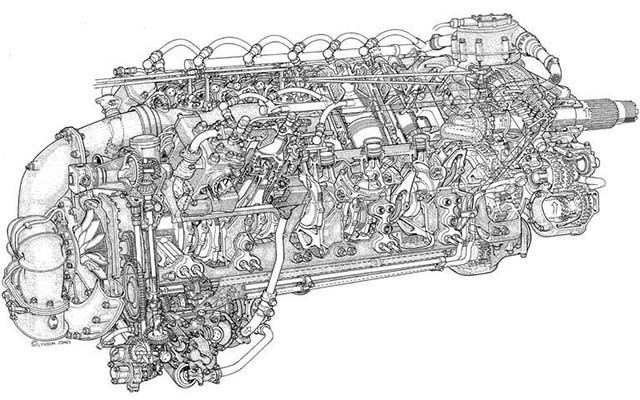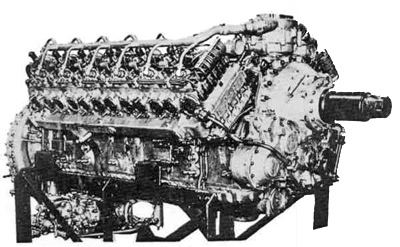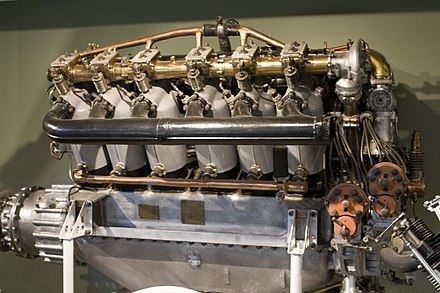 | ||
The Rolls-Royce Crecy was an unusual British experimental two-stroke, 90-degree, V12, liquid-cooled aero-engine of 1,536 cu.in (26 L) capacity, featuring sleeve valves and direct petrol injection. Intended for a higher-speed "sprint" variant of the Supermarine Spitfire fighter, the engine was developed between 1941 and 1945 it was the most advanced two-stroke aero-engine ever built.
Contents
- Design and development
- Technical description
- Sleeve valves
- Supercharging and exhaust turbine
- Test summary table
- Project cancellation
- Hawker Henley
- Supermarine Spitfire
- Specifications Crecy
- General characteristics
- Components
- Performance
- References

The engine was named after the Battle of Crécy; battles were the chosen theme for Rolls-Royce two-Stroke aero engines. There were no other Rolls-Royce engines of this type, and jet engines were subsequently given the names of rivers.

The Crecy was intended to power the Spitfire after flight testing in a converted Hawker Henley, but neither aircraft type flew with this engine fitted. The project was cancelled in December 1945 as the progress of jet engine development overtook that of the Crecy and replaced the need for this engine.

Design and development
Sir Henry Tizard, Chairman of the Aeronautical Research Committee (ARC), was a proponent of a high-powered "sprint" engine for fighter aircraft and had foreseen the need for such a powerplant as early as 1935 with the threat of German air power looming. It has been suggested that Tizard influenced his personal friend Harry Ricardo to develop what eventually became known as the Rolls-Royce Crecy. The idea was officially discussed for the first time at an engine sub-committee meeting in December 1935.

"The Chairman remarked that if it was the desire of the Air Ministry to develop a type of sprint engine for home defence....there was the question as to how far fuel consumption could be disregarded. Mr Ricardo had raised this point in a recent conversation by enquiring whether a high fuel consumption might not be permissible under certain circumstances, for if so, an investigation of the possibilities of the two-stroke petrol engine appeared to be attractive."
Previous experience gained between 1927 and 1930 using two converted Rolls-Royce Kestrel engines through an Air Ministry contract had proven the worth of further research into a two-stroke sleeve-valved design. Both these engines had initially been converted to diesel sleeve-valved operation with a lower power output than the original design being noted along with increased mechanical failures, although one converted Kestrel was subsequently used successfully by Captain George Eyston in a land-speed record car named Speed of the Wind. The second engine was further converted to petrol injection which then gave a marked power increase over the standard Kestrel.
Single-cylinder development began in 1937 under project engineer Harry Wood using a test unit designed by Ricardo. Although originally conceived as a compression ignition engine, by the time Rolls-Royce started serious development, in conjunction with the Ricardo company, the decision had been taken by the Air Ministry to revert to a more conventional spark-ignition layout, although still retaining fuel injection.
Technical description
The first complete V12 engine was built in 1941, designed by a team led by Harry Wood with Eddie Gass as the Chief Designer. Bore was 5.1 in (129.5 mm), stroke 6.5 in (165.1 mm), compression ratio 7:1 and weight 1,900 lb (862 kg). The firing angle was 30 degrees BTDC, and 15 lbf/in² (100 kPa) supercharger boost was typical. In bench-testing it produced 1,400 horsepower (1,000 kW), but there were problems with vibration and the cooling of the pistons and sleeves. The thrust produced by the exceptionally loud two-stroke exhaust was estimated as being equivalent to a 30% increase in power at the propeller on top of the rated output of the engine. The power of the engine was interesting in its own right, but the additional exhaust thrust at high speed could have made it a useful stop gap between engines such as the Rolls-Royce Merlin and anticipated jet engines. Serial numbers were even, because Rolls-Royce practice was to have even numbers for clockwise rotating engines when viewed from the front.
Sleeve valves
The reciprocating sleeve valves were open-ended, rather than sealing in a junk head. The open end uncovered the exhaust ports high in the cylinder wall at the bottom of the sleeves' stroke, leaving the ports cut into the sleeve to handle the incoming charge only. The sleeves had a stroke of 30% of the piston travel at 1.950 in (49.5 mm) and operated 15 degrees in advance of the crankshaft. The Crecy sleeve valves were of similar construction but differed in their operation compared to the rotary sleeve valve design that was pioneered by Roy Fedden, and used successfully for the first time in an aircraft engine, the Bristol Perseus, in 1932.
Supercharging and exhaust turbine
Supercharging was used to force the charge into the cylinder, rather than crankcase compression, as on most two-stroke engines. This allowed the use of a conventional lubrication system, instead of the total-loss type found in many two-stroke engines. Stratified charge was used: the fuel was injected into a bulb-like extension of the combustion chamber where the twin spark plugs ignited the rich mixture. Operable air-fuel ratios of from 15 to 23:1 were available to govern the power produced between maximum and 60%. The rich mixture maintained near the spark plugs reduced detonation, allowing higher compression ratios or Supercharger boost. Supercharger throttling was used as well to achieve idling. The supercharger throttles were novel vortex types, varying the effective angle of attack of the impeller blades from 60 to 30 degrees. This reduced the power required to drive the supercharger when throttled, and hence fuel consumption at cruising power.
Later testing involved the use of an exhaust turbine which was a half-scale version of that used in the Whittle W.1 turbojet, the first British jet engine to fly. Unlike a conventional turbocharger the turbine was coupled to the engine's accessory driveshaft and acted as a power recovery device. It was thought that using the turbine would lower fuel consumption allowing the engine to be used in larger transport aircraft. This was confirmed during testing, but failures due to severe overheating and drive shaft fractures were experienced.
Test summary table
The following table summarises the test running programme, hours run, and highlights some of the failures experienced.
Data from:
Project cancellation
The progress of jet engine development overtook that of the Crecy and replaced the need for this engine. As a result, work on the project ceased in December 1945 at which point only six complete examples had been built, however an additional eight V-twins were built during the project. Crecy s/n 10 achieved 1,798 horsepower (1,341 kW) on 21 December 1944 which after adjustment for the inclusion of an exhaust turbine would have equated to 2,500 horsepower (1,900 kW). Subsequent single-cylinder tests carried out on the Ricardo E65 engine achieved the equivalent of 5,000 brake horsepower (3,700 kW) for the complete engine. By June 1945 a total of 1,060 hours had been run on the V12 engines with a further 8,600 hours of testing on the V-twins. The fate of the six Crecy engines remains unknown.
Hawker Henley
If the Crecy had flown it would have done so in the Hawker Henley, L3385, that was delivered to Hucknall for conversion on 28 March 1943. This aircraft remained at Hucknall until 11 September 1945 when it was scrapped without ever having the engine fitted.
Supermarine Spitfire
Two years prior to the Hawker Henley's arrival (Summer 1941) a Supermarine Spitfire Mk II, P7674 had been delivered to Hucknall and was fitted with a Crecy mock-up to enable cowling drawings and system details to be designed. It had been agreed that the first production Spitfire Mk III would be delivered to Hucknall in early 1942 minus its Merlin engine for fitment of an airworthy Crecy, but this delivery did not occur. A Royal Aircraft Establishment report (No. E.3932) of March 1942 estimated the performance of the Spitfire fitted with a Crecy engine and compared this to a Griffon 61-powered variant. The report stated that the Crecy's maximum power output would be too much for the Spitfire airframe but that a derated version would have considerable performance gains over the Griffon-powered fighter.
Specifications (Crecy)
Data from The Rolls-Royce Crecy
